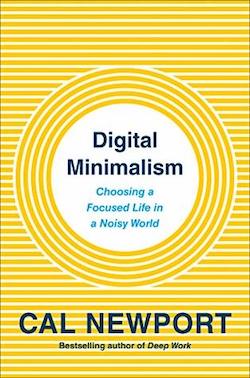 How much time do you think you spend on your phone every day? How much of that time is spent talking to an actual person on a phone call? How much is texting? How much is scrolling different apps?
How much time do you think you spend on your phone every day? How much of that time is spent talking to an actual person on a phone call? How much is texting? How much is scrolling different apps?
In one study one in three participants guessed they spent significantly less time on their smart phone than they actually do per day. While the average in this study was around five hours, some participants reported spending as many as twelve hours on their phone.
It’s no wonder, when the attention economy and social media are designed to keep people on their devices, using apps as much as possible.
Digital Minimalism: Choosing a Focused Life in a Noisy World (2019) by Cal Newport offers some ways to cut through all the things demanding our attention and decide what really matters.
Digital Minimalism is divided into two parts “Foundations” and “Practices.” The first half of the book establishes the problem and details some of the causes while the second half offers actionable strategies for change.
Newport calls his approach “digital minimalism”–a way to gauge exactly how much is enough without ever over-using. While this phrase might conjure an image of Luddites eschewing all technology, the book is quick to point out that rather digital minimalists adopt new technology and apps with caution. If a device or site doesn’t add value to a digital minimalist’s life, they do not use it.
The main tenet of digital minimalism is starting with a clean slate after a 30 day digital break in which you are not using your phone as anything but a phone and avoiding all of its apps and other features. After this detox period, digital minimalists are advised to evaluate what digital apps and devices they reintroduce with the following questions: Does this technology directly support something that I deeply value? Is this technology the best way to support this value? How am I going to use this technology going forward to maximize its value and minimize its harms?
Although Newport’s approach has been widely praised, he fails to acknowledge the intrinsic value in written communication/social media as tools for human connection. In other words, for Newport, friendships and connections are seen as having limited value if they cannot take place in person or at least over a phone call. I found this view dated and, given the number of long distance friendships I have, unrealistic. It is also one facet of digital minimalism that falls apart under the strain of the Covid-19 pandemic.
While Digital Minimalism doesn’t tread new ground (and fails to cite books by women who cover similar topics), Newport does present the information clearly and succinctly–particularly in the first half covering the ill effects of this digital age and how ill-equipped we all are for these massive changes. Practical tips including deleting apps in favor of web versions and turning off notifications may feel commonsense but fit in well with the overall approach.
Readers interested in a more practical step-by-step approach to using their phone less will be better served by How to Break Up With Your Phone by Catherine Price. Readers who want to think more about living with intention and joy should also check out Marie Kondo’s books The Life-Changing Magic of Tidying Up and Joy at Work (with Scott Sonenshein) and Burnout: The Secret to Unlocking the Stress Cycle by Emily Nagoski and Amelia Nagoski.
